In today’s rapidly evolving digital landscape, the demand for high-speed data transmission is paramount. Whether in modern data centers or telecom networks, the need for greater bandwidth and faster performance has led to the development and widespread adoption of 100G optical modules. These modules are critical components that enable data transmission at 100 gigabits per second (Gbps), offering a significant boost in speed compared to earlier technologies like 10G and 40G.
Introduction
The role of 100G optical modules in modern data centers is indispensable. As cloud computing, video streaming, and big data applications continue to proliferate, organizations require solutions that can handle these bandwidth-intensive applications efficiently. By leveraging 100G optical modules, companies can achieve faster, more reliable data transfer, ensuring that their infrastructure keeps up with the ever-growing demand for speed and capacity.
Moreover, telecom networks are increasingly relying on 100G modules to deliver seamless connectivity across vast geographical distances. Whether for interconnecting cities, countries, or continents, 100G technology offers the robust infrastructure needed to support long-haul transmission, making it a key enabler of global communications.
Types of 100G Optical Modules
100G optical modules come in several varieties, each designed for specific use cases and network environments. Here’s an overview of some of the most common types:
100GBASE-SR4
The 100GBASE-SR4 module is optimized for short-range connections, typically used with multimode fiber (MMF). It can transmit data over distances up to 100 meters using OM4 fiber, making it ideal for data centers where high-speed connections between racks or within the same room are required. The SR4 module employs parallel optics and utilizes four lanes of data transmission, with each lane handling 25 Gbps. Its low cost and high efficiency make it a popular choice for short-distance applications.

100GBASE-LR4
The 100GBASE-LR4 module, on the other hand, is designed for long-range transmissions and is used with single-mode fiber (SMF). It supports distances up to 10 kilometers, making it suitable for campus networks, data center interconnections, and other scenarios that require long-haul connectivity. The LR4 module uses Wavelength Division Multiplexing (WDM), where four different wavelengths are used to carry data simultaneously over a single fiber, improving both speed and efficiency.
100GBASE-ER4
For even longer distances, the 100GBASE-ER4 module is an excellent solution. It extends the reach up to 40 kilometers over SMF, making it well-suited for metropolitan area networks (MANs) and wide-area networks (WANs). Like the LR4, it also uses WDM technology to combine multiple data streams into a single optical fiber, allowing for efficient long-distance transmission. This makes the ER4 a preferred choice in telecom networks that require high-speed connectivity over vast distances.
CWDM4, PSM4, and ZR4
In addition to the SR4, LR4, and ER4 standards, other types of 100G optical modules are available to cater to specific needs:
- CWDM4 (Coarse Wavelength Division Multiplexing): CWDM4 is designed for data center interconnections and can transmit data over distances of up to 2 kilometers using SMF. It employs four different wavelengths like LR4 but operates over a shorter range.
- PSM4 (Parallel Single Mode 4): PSM4 utilizes eight single-mode fibers (four for transmitting and four for receiving) and supports distances up to 500 meters. It is primarily used in data centers where longer distances between servers and switches are required.
- ZR4: This module is built for ultra-long-range transmission, with distances extending beyond 80 kilometers. ZR4 modules are typically used in applications like long-haul optical transport networks (OTNs) and intercontinental connections.
Key Technologies Behind 100G Optical Modules
100G optical modules incorporate several advanced technologies to achieve their impressive data transmission rates and distances. Three of the most important technologies include Wavelength Division Multiplexing (WDM), PAM4 Modulation, and Forward Error Correction (FEC).
- Wavelength Division Multiplexing (WDM)
WDM is a core technology behind many 100G optical modules, particularly those designed for long-range use, like LR4 and ER4. WDM allows multiple data streams to be transmitted simultaneously over a single optical fiber by using different wavelengths (or colors) of light for each data stream. This dramatically increases the fiber’s capacity without the need to install additional fibers, making it a cost-effective and efficient solution. There are two types of WDM commonly used: Dense Wavelength Division Multiplexing (DWDM) and Coarse Wavelength Division Multiplexing (CWDM), with DWDM supporting more channels and longer distances. - PAM4 Modulation
PAM4 (Pulse Amplitude Modulation 4-Level) is another key technology that allows 100G modules to achieve higher data rates. Unlike traditional binary modulation, which encodes data as either a 0 or a 1, PAM4 uses four distinct signal levels to represent two bits of data per symbol. This effectively doubles the data rate without increasing the baud rate (the number of signal changes per second). PAM4 is crucial in achieving 100 Gbps speeds while maintaining compatibility with existing optical networks. - Forward Error Correction (FEC)
FEC is a method used to ensure reliable data transmission, particularly over long distances. It works by adding redundant data (error-correcting codes) to the transmitted signal, allowing the receiver to detect and correct errors without needing retransmission. This is especially important in high-speed optical networks, where data integrity is critical, and retransmissions can cause significant delays. FEC helps maintain high data transmission quality even when the signal degrades over long distances or through noisy environments.
Conclusion
100G optical modules have revolutionized modern networking by enabling faster data transmission, higher bandwidth, and more efficient network infrastructure. Whether for short-range connections in data centers or long-distance telecom networks, the variety of 100G modules available—each tailored for specific applications—makes them versatile solutions. The underlying technologies, such as WDM, PAM4, and FEC, ensure these modules can deliver reliable, high-performance connections, driving the future of digital











